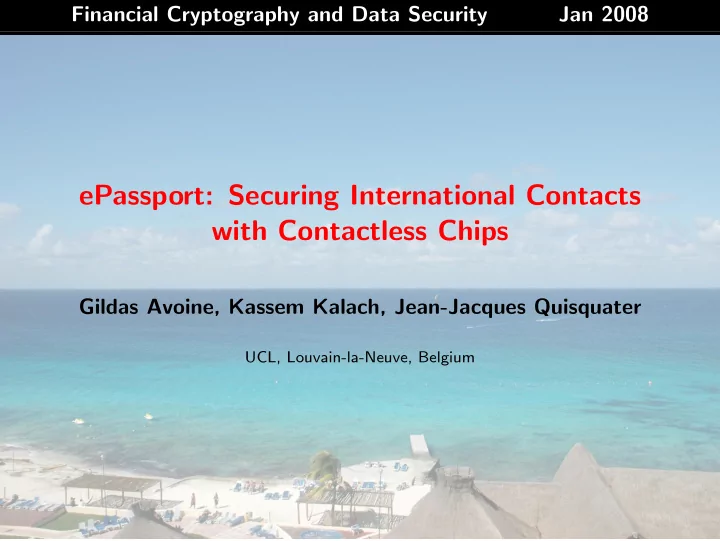

Financial Cryptography and Data Security Jan 2008 ePassport: Securing International Contacts with Contactless Chips Gildas Avoine, Kassem Kalach, Jean-Jacques Quisquater UCL, Louvain-la-Neuve, Belgium 1/15
Summary ⊲ EPassport Specifications ⊲ Cryptographic Tools ⊲ Attack on BAC Keys ⊲ Improvements & Weaknesses 2/15
A Few Facts About Passport History ⊲ International Civil Aviation Organization (ICAO) ⊲ ICAO works on electronic passport (ePassport) since late 90s ⊲ ICAO Standard (Doc 9303) released in 2004 ⊲ First ICAO-compliant electronic passport issued end 2004 ⊲ More than 50 countries today ⊲ Securing passports with chip: Davida & Desmedt Eurocrypt’88 ⊲ First electronic passports: Malaysia (1998) 3/15
Technical Specifications Contactless chip = microcircuit + antenna = RFID tag Chip ⇒ Security, Contactless ⇒ Convenience Tag is passive ie no internal battery Tag has a microprocessor (public-key crypto) Compliant ICAO Doc 9303 and ISO 14443 Distance 10 cm, 70–100 cm (exp) 4/15
Logical Data Structure 5/15
State and Citizen’s Protection State’s protection Modifying data of a given passport Passive Authentication [Signature] Forging a fake passport RSA, DSA, ECDSA SHA−1, 224 ,256 ,384, 512 Active Authentication Cloning a given passport [Challenge Response] ISO 9796−2 Citizen’s protection Basic Access Control Skimming a passport [Reader Authentication] TDES/CBC Retail−MAC/DES SHA−1 (key der.) Secure Messaging Eavesdropping the communication [Encryption] TDES/CBC Retail−MAC/DES 6/15
Basic Access Control and Secure Messaging Passport Number Expiration Date Birth Date MRZ Reader Passport Cp Basic Access Control a = ENC(Cp, Cr, Kr), MAC(a) Encryption Key b = ENC(Cp, Cr, Kp), MAC(b) MAC Key Kr, Kp Reader Passport Secure Messaging Authenticated Query Session Encryption Key Encrypted Data Session MAC Key 7/15
BAC Keys’ Entropy ⊲ According to ICAO, birth year must be encoded on 2 digits (15.15 bits), expiry delay should be max 10 years (11.83 bits), and passport number must contain no more than 9 alphanum characters (46.53 bits) Theory 73 ⊲ In practice, generation of passport numbers let to discretion of countries. Numbers are structured (eg 00AA00000) with some non-random parts (eg letters represent the issuing office). Germany 55 [CarluccioLPS] USA 54 [JuelsMW] Netherlands 50 [Robroch] 8/15
Heuristics on Belgian Passport ⊲ Expiration delay is 5 years only ⊲ No passports issued during week-ends and vacation days ⊲ Passport numbers have only 8 characters (6 digits, 2 letters) ⊲ Passport numbers do not look like random numbers 9/15
Analysis of Belgian Passport Numbers 10/15
Reducing Searching Area 11/15
Belgian Passport Entropy Country Effective Birth date known Belgium 38 23 Attack do-able in practice? 12/15
Various Attacks on Belgian Passports ⊲ On-line attack (Skimming): about 400 queries/min ◮ The passport acts as an oracle ◮ In lab: Easy to Hard , In real life: Hard to Infeasible ⊲ Off-Line attack (Eavesdropping): about 2 23 tests/s (Doe’s PC) ◮ Require material to be decrypted ⇒ eavesdropping, not skimming ◮ Signal sent by the reader can be listened at several meters ◮ In real life: Very easy Type Number Machine-readable 430 000 ⊲ Pragmatic attack ePassport Gen 1 720 000 ◮ In real life: Cannot be easier ePassport Gen 2 350 000 Total 1 500 000 13/15
Skimming a Gen 1 Belgian Passport 14/15
Improvements & Weaknesses Possible Improvements: ⊲ Radio blocking shield ⊲ Delay chip answers ⊲ Random passport numbers ⊲ Add entropy with the optional field of the MRZ ⊲ Separate BAC keys and MRZ Potential other weaknesses: ⊲ The administration interface is not standardized ⊲ Combination of algorithms not standardized ⊲ Everyone can require the chip to sign (random) data ⊲ Relay attacks ⊲ Analysis of the encrypted communication ⊲ And probably more... 15/15
Recommend
More recommend